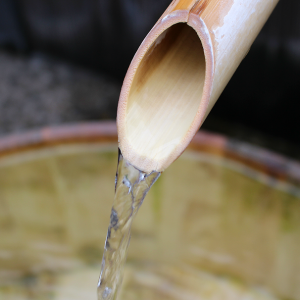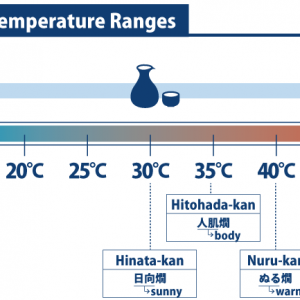
One of the great things about sake is its wide range of serving temperatures. Broadly speaking, sake can be served chilled (hiyazake), at room temperature (jo-on) or warmed (kanzake). The best serving style may come down to the sake, the setting, dish pairing or simply individual preference. In Japan, these serving temperatures are typically expressed in 5°C (9°F) increments, each with its own delightfully poetic name.
Chilled Sake
5°C (41°F), yuki-hie (雪冷え): Yuki-hie literally means “snow chilled,” a fitting description and generally the lowest temperature you should go with most sake.
10°C (50°F), hana-bie (花冷え): Hana means “flower,” with this name referring to a cold-snap at the beginning of spring when the cherry blossoms start to appear.
15°C (59°F), suzu-hie (涼冷え): Suzu means “refreshingly cool” like a pleasant autumn breeze.
Sake can also be served semi-frozen as mizore–zake (みぞれ酒). Mizore means “sleet,” but can also refer to shaved ice, a popular treat for children in Japan. Frozen sake has a crunchy, sherbet-like texture and provides a novel twist to the sake experience.
What is Room Temperature?
The definition of “room temperature” varies by country, but in Japan it’s approximately 20-25°C (68-77°F). Sake at room temperature is mellow on the palate with a more pronounced aroma than chilled sake. Sake at tasting events is generally served at room temperature as this gives a clearer idea of the flavor profile.
In Japan, sake served at room temperature is historically known as hiya (冷や), meaning “cold.” This term dates back to before the advent of refrigeration, when the only options were to serve sake at room temperature or warmed. While veteran sake fans know the term refers to room temperature sake, it can understandably lead to confusion even in Japan. For this reason, its use is now somewhat controversial.
Warmed Sake
Warmed sake can either be called kanzake (燗酒) or atsukan (熱燗), although the latter officially means sake served at 50°C (122°F).
30°C (86°F), hinata-kan (日向燗): Hinata means a sunny spot, pleasantly warm like this sake.
35°C (95°F), hitohada-kan (人肌燗): Hitohada uses the kanji for person and skin, meaning body temperature.
40°C (104°F), nuru-kan (ぬる燗): Derived from the adjective nurui, meaning lukewarm, this term can also refer more broadly to any sake that is not excessively hot.
45°C (113°F), jo-kan (上燗): Jo means “upper.” The next level of heat after this is atsukan, which is around 50°C (122°F).
55°C (131°F), tobikiri-kan (飛び切り燗): Tobikiri means “extremely” or “exceptionally.” Everything from this temperature up is categorized as tobikiri-kan.
Of course, there is no need for sake fans to learn all of this terminology. However, it helps to be aware of the subtle differences that even a small change in temperature can bring about. The terms listed above illustrate sake’s unlimited depth and are part of Japan’s richly fascinating sake culture.
*If you would like us to send you monthly updates and information, register here.





Comments